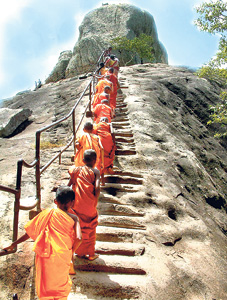Most civilizations were born after long bloody wars. Human behavioural patterns and facets of culture take root to grow thereafter. The story of our own Buddhist civilization and culture has no parallel in history. The drama, that took place about 236 years after Sakyamuni Gotama Buddha's demise, (Maha-Parinibbana), has an air of religious fervour and a link with mother India, where the great Master lived.
After the historic Kalinga war in India, Emperor Asoka witnessed the river Mahanadi turn red with the blood of his slain countrymen.
Deeply grieved he resolved never thereafter to go to war. "Chanda Asoka" (i.e. the wicked Asoka) soon became known in history as "Dharma Asoka" ("Righteous Asoka").
The Pali Chronicle, Culavansa has stated that before the Maha Parinibbana of the Buddha at Kusinara, it was foretold that 236 years later a great sage named Mahendra would cause the splendour of the Buddha religion to shine in Lanka Deepa, and in a city the King will cause to build the Thuparama dagoba to enshrine the Buddha's relics, symbolizing the presence of Gotama Buddha.
In that historic background, along with a retinue of Buddhist monks, Emperor Asoka sent his son Mahinda, (he was known as Mahendra in India) to carry with him the noble message Buddha gave to the world. The fact that a member of the royal Maurya family was sent to Lanka Deepa on this mission, gave importance to the historic event.
The arrival of the sage
According to the Mahavansa (The Great Chronicle) the sage Maha Mahinda on an uposatha (Poya) day, in the month of Jetta (June) rose up in to the air, (propelled by deep sila and developed concentrated mind) and, departed with wonderous powers he possessed, to alight at the Missaka mountain, at Ambastale in Mihintale. The sage met King Devanampiyatissa, (named beloved of the Gods) who with several of his courtiers was on a deer hunt. It is said that the King laid down his bow and arrow and listened to the "Chula Hatti Padupama Sutta" (a Buddhist discourse), which sums up the essence of the noble Buddha Dharma (philosophy).
At the end of the discourse, the king and his entire retinue embraced Buddhism. Thus it could be said that it brought about the social and religious revolution in ancient Sri Lanka and was the beginning of the Sinhala Buddhist race. He thus became the first consecrated ruler of Lanka. This was also the beginning of the Buddhist monastic order in Sri Lanka.
Soon after the Buddha's teachings were accepted and followed by all his subjects. Buddhism in later years was fostered in a big way by other Sinhala kings - Dutugemunu, Valagamba, Mahasen, Dhatusena, Vijayabahu.
As the years passed there emerged a new Buddhist Sinhala culture, with distinct art forms in stone and also paintings in rock caves, - sculpture of Dagoba Vahalakade (Gateways) with figures of swans, Dwarfs, birds, elephants, deities, punkalas with liyaveli etc. At the Kantaka Chetiya (stupa) the ornamental pots and floral designs signify "abundance", - the richness of all life.
The entire Mihintale temple complex at a lower elevation is studded with ruins, in rock, all of great archaeological value - monasteries indicating that thousands of Buddhist monks lived there. The ruins (now restored) of a large hospital (a vajja – sala) built in the ninth century A.D, and a subterranean water/sewage system indicate the advanced level of the civilization.
The caves at upper levels have inscriptions which according to Prof. Senarat Paranavitana belonged to an Indo-Aryan family of languages, such as Sanskrit. The caves which provided shelter for monks had second century Brahmic inscriptions, and were fashioned for occupation by potters, metal workers, astronomers, architects and merchants. Pots and blue coloured urns unearthed indicate that there were trade links with Persia (modern Iran).
Two stalwarts
The excavation of ruins around the Mihintale Temple took place after 1910, with H.C.P Bell as Archaeological Commissioner. Pilgrims who flock in their thousands annually, during the Poson festival, remember with gratitude two pioneers who blazed a trail to make the spotlight fall on Mihintale.
The fiery orator Valisinha Harischandra single-handedly, verbally fought against British colonialists regarding the unjust implementation of the Waste Lands Ordinance by which weapon the AGA strove to confiscate property of the Mihintale Temple. Harischandra went to prison on many an occasion for inciting the sentiments of Buddhist crowds, urging them to defy the Government Agent's orders. There are statues erected in his honour at the Maha Vidyalaya, Anuradhapura and Harischandra Maha Vidyalaya, Negombo in his village. A close friend of Anagarika Dharmapala, they fearlessly teamed up to promote Buddhist activity, and fought against oppression of Buddhist activity.
The other legendary figure we should remember is Prof. Senarat Paranavitane, our one-time Archaeological Commissioner He had his training as an epigraphist at Dhera-Dun in North India, and worked with the famous archaeologist Sir John Marshall Kt. who, in later times along with Sir Alexander Cunningham helped unearth the story of Sanchi in Bopal. Braving hard times, when malaria was a deadly menace in the whole of the Rajarata, and living out doors without proper sanitation, this pioneer archaeologist gave Mihintale a new face. They say, that if ever Paranavitane saw a twelve-foot mound of earth, his X-ray eyes would soon say that, there lay buried a Vahalkada or Image House.
A unique story
The advent of Buddhism to Lanka with Maha Mahinda's visit is a unique story. The religious conversion of all people was done peacefully. That King Devanampiyatissa laid down his bow and arrow indicates kindness to all reigned supreme. He then accepted th Buddha Dharma which refers to a righteous life for all to follow. It is an unalloyed Dharma noble and everlasting. |

